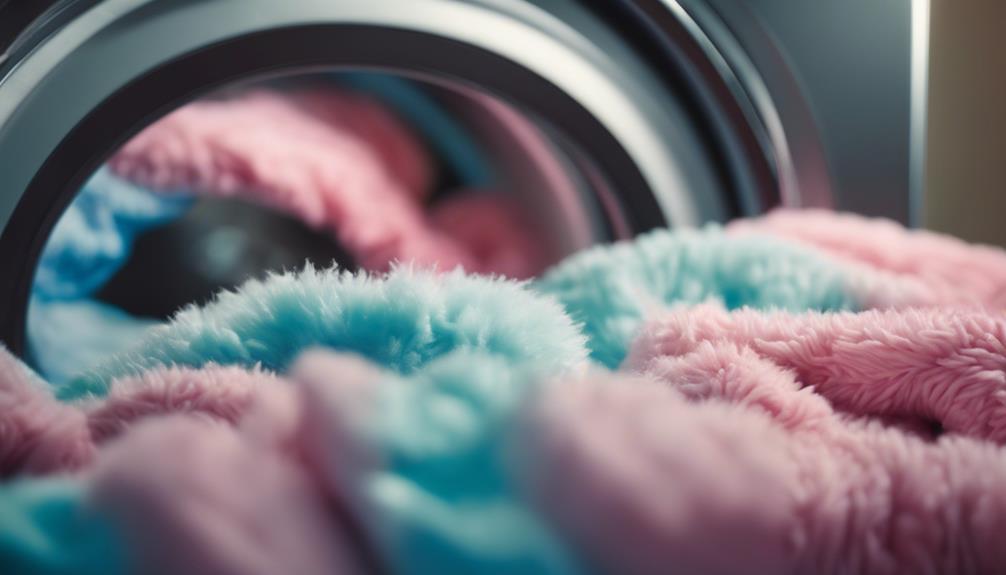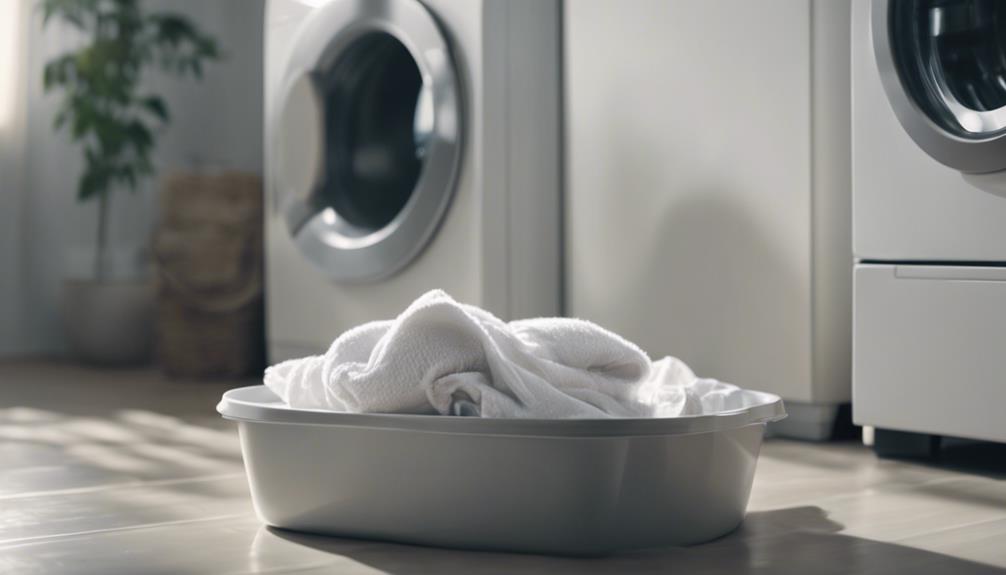Washing a comforter with a strong agitator may damage delicate fabrics due to the vigorous movements. This can result in tearing, pilling, or loss of fluffiness. Fabrics like silk or velvet are particularly vulnerable. To preserve fabric quality, it is recommended to use a washer without an agitator or opt for hand washing. Choosing the right washer size is crucial for a thorough cleaning. Larger comforters may require commercial washers. If you are interested in learning more about how agitators impact comforter care and maintaining fabric quality, you can explore additional details on proper washing techniques.
Key Takeaways
- Agitators can damage delicate comforter fabrics.
- Tearing, pilling, and deformation are risks.
- Opt for agitator-free washers for fabric preservation.
- Consider hand washing delicate comforters.
- Agitator washers may cause uneven cleaning.
Potential Damage to Delicate Fabric

Using an agitator in washers can pose a significant risk of damaging delicate fabrics like comforters due to their vigorous washing action. The forceful movements of the agitator can agitate and tumble the comforter excessively, leading to potential damage such as tearing, pilling, or deformation in the fabric. Delicate comforter materials like silk, satin, or velvet are especially vulnerable to such harm when washed with an agitator. Additionally, the aggressive washing action can result in uneven cleaning and may cause a loss of fluffiness in the comforter's filling.
To preserve the quality and lifespan of delicate comforters, it's advisable to utilize agitator-free washers or opt for hand washing methods. By avoiding the use of agitators, you can minimize the risk of damage to delicate fabrics, ensuring that your comforter remains in good condition for an extended period. This approach helps maintain the fluffiness and overall quality of the comforter, extending its lifespan and keeping it looking and feeling its best.
Harsh Cleaning Capabilities of Agitators

The aggressive nature of agitators in washers can result in significant wear and potential damage to delicate comforter fabrics. The agitation caused by these mechanisms can be too harsh for delicate fabrics, leading to tangling and twisting of comforter fibers during the washing process. While agitators excel at heavy-duty cleaning tasks, they may not provide the gentle care required for maintaining the quality of comforters.
Excessive friction generated by the forceful action of agitators can have a detrimental effect on comforter materials, affecting their longevity over time. It's important to take into account these factors when deciding whether to use a washer with an agitator for washing your comforter, as the priority should be on ensuring the gentle treatment necessary for preserving the comforter's quality. Opting for a washing method that offers a more delicate approach can help prevent damage and guarantee the longevity of your comforter.
Recommended Washer Type for Comforters

When selecting a washer for your comforter, consider the size compatibility to guarantee it fits comfortably for a thorough wash.
Evaluate the impact of the agitator on your comforter material, as some fabrics may require gentler washing methods.
Follow fabric care tips to maintain the quality and longevity of your comforter through the washing process.
Washer Size Compatibility
For washing comforters efficiently, it is advisable to use a top load washer with at least 3.8 cubic feet capacity when dealing with king size comforters. Standard washers with agitators can effectively wash twin and full comforters. However, larger comforters may require the use of commercial washers or dry cleaners due to size constraints. It's important to adhere to the manufacturer's instructions and load the comforter properly in a washer with an agitator for best cleaning results.
| Washer Type | Capacity | Recommended Comforter Size |
|---|---|---|
| Top Load with Agitator | 3.8 cubic feet | King Size |
| Standard with Agitator | Varies | Twin & Full |
| Commercial Washer | Larger | Oversized |
Agitator Impact Analysis
When washing comforters with an agitator, it's important to take into account the potential impact of the agitator on the fabric's delicacy and stain removal effectiveness.
Agitators, known for their deep cleaning capabilities and effectiveness on heavily soiled items, can be too rough for delicate fabrics like comforters. While they excel at removing tough stains, there's a risk of fabric damage or tearing.
For a gentler wash that's more suitable for delicate comforters, consider using an agitator-free washer. These washers offer a more gentle wash cycle, are spacious enough for large items like comforters, and are generally considered safer for delicate fabrics.
Switching to an agitator-free washer can help maintain the integrity of your comforter while still achieving a deep clean.
Fabric Care Tips
For the best care of your comforter, we suggest choosing a washer type that doesn't include an agitator. Washing delicate fabrics like those found in duvets or comforters with intricate stitching in a washer without an agitator can help prevent tangling and guarantee even cleaning.
Agitators, while great for deep cleaning heavily soiled items, may not be ideal for maintaining the quality of delicate or intricately designed comforters. The gentle washing motion of agitator-less washers can be more suitable for preserving the fabric and stitching of your comforter, ensuring it stays in good condition for longer.
When it comes to fabric care, selecting the right washer type tailored to your comforter's needs can make a significant difference in its longevity and cleanliness.
Advantages of Washers Without Agitators

Washers without agitators offer users numerous advantages when it comes to cleaning comforters efficiently and effectively. These machines provide ample room for a full load of laundry, including bulky comforters, ensuring a thorough cleaning process.
The absence of an agitator in the machine also means a gentler wash cycle, reducing the risk of damage to delicate comforters. Additionally, these washers operate in an energy-efficient manner, helping users save on utility costs over time.
The quiet performance of washers without agitators is particularly beneficial in home settings, minimizing noise disruptions during laundry cycles. Moreover, advanced features such as smart technology enhance the user experience by providing added convenience and functionality.
When it comes to caring for comforters, opting for a washer without an agitator can lead to excellent results, making it an excellent choice before transferring the comforters to the dryer for a thorough dry cycle.
Gentle Washing Experience for Comforters

After exploring the benefits of washers without agitators for cleaning comforters effectively, it becomes evident that a gentle washing experience is essential for maintaining the quality and longevity of these bedding essentials.
When dealing with delicate materials and intricate stitching found in many comforters, opting for an agitator-free washer is the way to go. These washers provide a large capacity for accommodating bulky items like comforters while ensuring a gentle washing cycle that preserves the quality of the bedding.
Suitability for Bulky and Delicate Items

When considering washing bulky comforters in a machine with an agitator, it's important to weigh the benefits of deep cleaning against potential damage to delicate fabrics. Agitators excel at handling tough stains on larger items but may not be the best choice for more fragile materials.
Carefully assess the fabric type and level of soiling before deciding whether to use an agitator washer for your comforter.
Bulky Items Care
For handling bulky items like comforters, the deep cleaning abilities of agitator washers make them a reliable choice. Agitator washers are designed to effectively agitate and clean large, heavy items such as comforters. Their durability is well-suited for handling bulky bedding items, making them a popular choice for users with heavily soiled comforters that require thorough cleaning.
When it comes to tackling tough stains and grime on bulky comforters, the agitator's design proves to be highly effective. With an agitator washer, you can trust that your comforter will receive the deep cleaning it needs to remove dirt and stains effectively, ensuring a fresh and clean outcome every time.
Delicate Fabrics Handling
For the safe washing of delicate fabrics like comforters, it's important to opt for a washer without an agitator for gentle handling. Agitator washers, with their rough washing motion, may not be suitable for delicate items such as bulky comforters. Delicate fabrics can easily get damaged or tangled in agitator washers, compromising the fabric integrity and overall quality.
To preserve the fabric integrity and guarantee proper care, it's recommended to use a large, top load washer without an agitator. Always check the care label on your comforter for specific washing instructions and select a washing machine that aligns with the guidelines for washing delicate fabrics. This approach will help maintain the quality and longevity of your delicate comforters.
Washing Machine Suitability
Agitator washing machines offer effective handling of both bulky and delicate items, guaranteeing thorough cleaning and durability. These machines are suitable for washing comforters due to their robust cleaning performance.
The agitator motion helps in deep cleaning and removing stains from comforters, making them a preferred choice for heavy fabrics that require a thorough wash. Their durability and ability to handle bulky items make agitator washers ideal for maintaining the cleanliness and longevity of comforters.
When washing a comforter with an agitator, it's advisable to use a gentle cycle to prevent any damage to the fabric or filling. This setting ensures a proper clean while maintaining the integrity of the comforter during the wash cycle.
Frequently Asked Questions
Can You Wash a Comforter in a Washer With an Agitator?
Yes, washing a comforter with an agitator is possible, but it requires caution to prevent damage. Agitators can be rough on delicate fabrics, potentially causing tangling, tearing, or stretching.
To protect the comforter, follow care label instructions and use a gentle cycle. Consider using a mesh laundry bag to shield the comforter from direct contact with the agitator for a more gentle wash.
Always prioritize the comforter's care to maintain its quality and longevity.
How to Wash a Comforter in a Top Loader?
When washing a comforter in a top loader, follow these steps for a clean and fresh outcome:
Start by using a gentle cycle and slow spin speed to prevent damage.
Add an extra spin cycle for faster drying.
Swap fabric conditioner for white vinegar to maintain freshness.
Tumble dry on low heat to keep fluffiness.
Make sure it's fully dry before storing to avoid mildew.
These tips keep your comforter cozy and clean.
What Setting Do You Put the Whirlpool Washer on for Comforters?
When washing a comforter in a Whirlpool washer, choose the bulky or bedding cycle for best cleaning results. These cycles provide the necessary agitation and water levels to effectively clean the comforter.
Avoid using the delicate cycle as it may not offer sufficient cleaning action. Make sure the comforter has enough space to move freely in the washer to prevent damage and guarantee thorough cleaning.
Follow the manufacturer's instructions for loading the comforter and selecting the appropriate cycle.
How Big of a Washer Do I Need to Wash a Queen Size Comforter?
To wash a queen size comforter effectively, you'll need a washer with a capacity of at least 3.5 cubic feet. For king size comforters, opt for larger washers, around 3.8 cubic feet. It's important to make sure the comforter has enough space to move freely for proper cleaning.
For oversized comforters, consider using a commercial washer at a laundromat. Always follow the care label instructions specific to the comforter's material for best washing results.
Is it Safe to Wash a Comforter with an Agitator Like Hotels Do?
Many people wonder if it is safe to wash a comforter with an agitator like hotels do. According to a recent hotels wash comforters article, it is generally safe to wash your comforter in a machine with an agitator, as long as you follow the care instructions on the label.
Conclusion
To sum up, washing a comforter with an agitator may lead to potential damage due to the harsh cleaning capabilities of these machines.
It's advisable to use a washer without an agitator for a gentle washing experience that's suitable for bulky and delicate items.
By selecting the right washer type, you can guarantee the longevity and quality of your comforter.
Remember, a gentle touch goes a long way in caring for your bedding.










